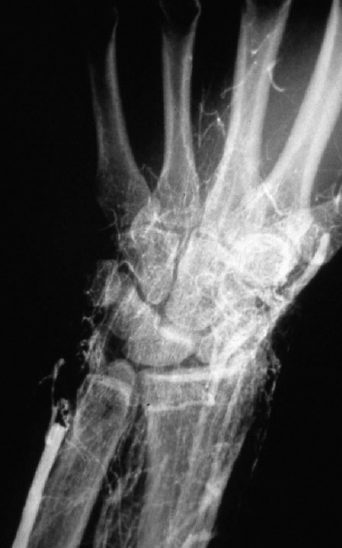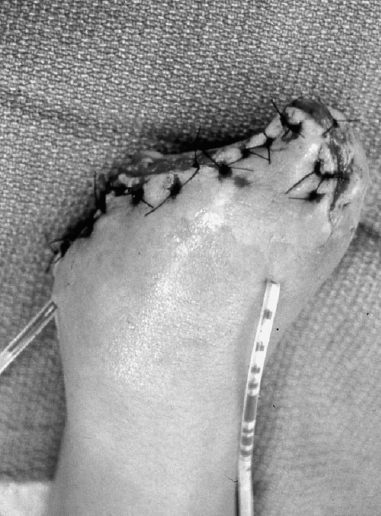2
Injuries to the Dermis: Cold Injuries
Sokratis Varitimidis, Robert J. Goitz, and Dean G. Sotereanos
History and Clinical Presentation
A 48-year-old, right hand dominant man was admitted to the emergency room 24 hours after a fall from a 20-foot height while hiking. The hikers who found the patient reported he had been exposed to temperatures below 0°C with only a light blanket.
Physical Examination
On examination, the patient denied pain, but his left hand was discolored and mottled, and he had diminished sensation. He was unable to flex or extend the fingers of his left hand. His core body temperature was 34°C, and his vital signs were normal. His body was immediately rewarmed with warm oral and intravenous fluids. Tetanus prophylaxis was given and the affected hand was placed in circulating warm water (42°C) for 30 minutes.
Within 24 hours, blisters were noted on his digits (Fig. 2–1) and he had significant pain. The hand continued to exhibit diminished sensation, and the digits appeared ischemic. The entire skin of the hand was covered with aloe vera ointment and dressed with a sterile soft dressing. An axillary block was performed to provide a sympathetic block to aid in pain control.
PEARLS
- Rapid rewarming of the hand in a whirlpool at 40° to 44°C for 15 to 30 minutes
- Protection of the skin with aloe vera or silver sulfadiazine is encouraged. Consider blister aspiration
- Administration of a nonsteroidal antiinflammatory drug (NSAID) if not contraindicated by other medical problems.
- Observe for ischemia and demarcation for up to 2 months before amputation is performed.
- Triple-phase bone scan may help guide early salvage with debridement and flap coverage if young age or bilateral involvement.
PITFALLS
- Slow rewarming may cause more tissue damage.
- Early debridement of blisters should be avoided.
- Amputation of the frostbitten part before a clear line of demarcation appears is strongly contraindicated, unless aggressive early salvage is considered.
Diagnostic Studies
Three days after admission, a bone scan was performed. It showed no activity in the fingers or distal palm. An arteriogram of the left upper extremity revealed no flow distal to the wrist (Fig. 2–2).

Figure 2–1. Blisters developed on the left hand 24 hours following rewarming.

Figure 2–2. Arteriogram without flow distal to the palm.
Differential Diagnosis
Acute frostbite
Raynard’s disease
Raynard’s syndrome
Vascular disease
Neurogenic disease
Acute Frostbite
The diagnosis of acute frostbite injury can be made immediately by the patient’s history and examination. Acute thrombosis may be considered but is less likely when considering the history of extended cold exposure.
Diagnosis
Frostbite of the Hand
Frostbite may be defined as damage to tissue as a result of sustained exposure to low environmental temperatures. Ice crystals form in the extracellular space, resulting in an osmotic gradient, cellular dehydration, and electrolyte imbalance. In addition, direct injury to endothelial cells may result in thrombus formation. The combination of cellular dehydration, vasoconstriction, and thrombus formation may result in severe peripheral vascular collapse and ischemia.
There are multiple factors influencing the severity of injury and the eventual outcome. The most important factors are the degree of cold penetrating the tissues and the duration of exposure. Additional factors that promote heat loss are immobility, hyperventilation, inadequate protective clothing, contact with moisture or bare metal, and the wind-chill effect. Host factors include alcohol, age, mental illness, compromised peripheral vasculature, and infection.
Angiography has been used clinically to help determine the extent of vascular constriction and tissue ischemia from cold injuries. During the healing phase angiography can provide information on new collateral circulation to the affected region. Triple phase bone scanning has been found to correlate directly with the final extent of tissue damage and may be useful as early as 48 hours after the injury. Magnetic resonance imaging (MRI) and magnetic resonance angiography (MRA) have also been used to assess vascular occlusion and degree of tissue ischemia with reasonable success.
Nonsurgical Treatment
The management of frostbite is started immediately upon presentation. After stabilizing the patient’s general condition, emphasis is placed on regulating body temperature through air circulation, body warmers, and warm liquids administered both orally and parenterally. The affected area is rapidly rewarmed in circulating warm water (40° to 44°C) for 15-to 30-minute intervals. This process may be quite painful and usually requires administration of parenteral analgesics. Regional anesthesia may also be considered if severe pain is encountered. Multiple studies have confirmed the benefits of rapid rewarming versus slow rewarming (Table 2–1).
Surface blisters appear within the first 24 to 48 hours after rewarming, and evidence suggests that blisters contain metabolites of arachidonic acid, which may potentiate progressive dermal ischemia. Topical application of aloe vera to intact blisters is recommended because aloe is a topical thromboxane inhibitor and may combat its vasoconstricting effects. Aspiration of blisters is another way to lessen their ischemic effect. Ruptured blisters are treated with 1% sulfadiazine cream. Systemic antibiotics are used if infection is apparent. Tetanus prophylaxis is administered according to usual guidelines. Ibuprofen is also administered to inhibit the effects of arachidonic acid metabolites and has been shown to decrease the amount of tissue ischemia and subsequent necrosis. Functional splinting with custom-made orthoses may be helpful in patients who exhibit progressive contractures.
| 1. Stabilize the patient |
| 2. Systemic rewarming with warm environment and warm fluid resuscitation |
| 3. Rewarming of the extremity with circulating warm water (40° to 44°C) for 15- to 30-minute intervals |
| 4. Tetanus prophylaxis |
| 5. Analgesics and/or sedatives |
| 6. Elevation of the affected extremity |
| 7. Application of aloe vera on intact blisters and silver sulfadiazine cream on ruptured blisters; consideration of blister aspiration |
| 8. Nonsteroidal antiinflammatory drug (NSAID) |
| 9. Early immobilization followed by early range of motion exercises after 48 to 72 hours |
| 10. Consideration of axillary block to provide sympathectomy and pain control |
| 11. Antibiotics only if infection is present |
Surgical Treatment
Absolute indications for early surgical intervention are for infection or escharotomy if viability is compromised secondary to the eschar. Midlateral incisions of a digit allow for decompression and may heal by secondary intention.
Traditionally, surgical intervention for digital frostbite has paralleled treatment for ischemic digits. That is, allowing for clear demarcation of nonviable tissue prior to amputation maximizes retention of viable tissue and minimizes possible need for revision amputation or possible infection if necrotic tissue is retained.
In the case presented, the patient was observed for 6 weeks, at which time it was determined that all five digits and half of the palm were necrotic and mummified; amputation of the hand at the level of demarcation was performed (Fig. 2–3). All necrotic tissues (skin, tendons, and bone) were removed and the wound was closed primarily with healthy skin.










